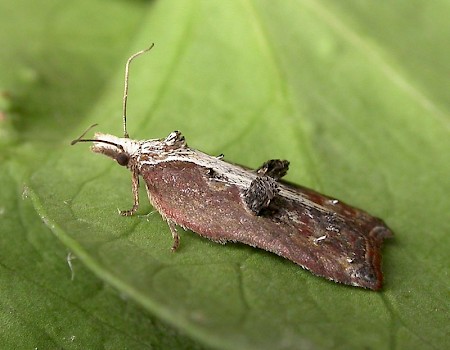Acleris Cristana - Paul Kitchener, UKMoths
Dr Phil Sterling is an expert on moths, and author of several books on moths and their caterpillars. We asked him ‘are there any moths that stump you when trying to identify them?’ and his response reveals all.
“Yes, there definitely are. I’m an expert and I’ve been doing this all my life, and there are quite a lot of moths that stump me. Moths are loosely divided into two major groupings. There are the macro-moths, the larger ones, of which there are around 800 species, and most of these are moderately easy to identify once you’ve got used to the different varieties and the variation some show within a species. Then there are the micro-moths, the smaller ones, of which there are at least 1300 species, with more being discovered each year. Lots are easy enough to identify, but many require time to identify properly, along with access to books, websites and crucially a decent x10 hand lens or a low powered binocular microscope. Micro moths are generally harder to identify because their smaller wings have fewer diagnostic features on them to help. But some micro-moths are spectacularly variable, such as Tufted Tortrix, Acleris cristana, which has over 100 different varieties described (see Acleris cristana on the UKMoths website for some of the varieties).
Why are there so many varieties in moths?
We don’t always know why the variations are there, but it will be to do with a survival mechanism. Most adult moths rely on their wing shape and pattern to help them become cryptic against their background and avoid being detected by a predator such as an insectivorous bird. Most moths seem to be able to rely on a single wing pattern to achieve this but some, like the Tufted Tortrix, are what’s known as polymorphic, they have lots of forms. Birds learn patterns to detect what is and isn’t food in their environment, so the Tufted Button, by having so many different patterns at least some will avoid being eaten.
One giant of a moth whose forewing always looks pretty much the same is the Clifden Nonpareil. How does it get away with this? They’re mottled grey and during the day they rest on the bark of a Poplar or Aspen tree which is also mottled grey and so they blend in remarkably well. For them, looking different from the bark of the tree they sit on isn’t an option. But they have a defence mechanism under their forewings. If a bird sees one and starts to peck at it, the moth flashes its blue striped hindwing and grey and white underside, startling the bird and allowing this fast-flying moth to escape.
So, to limit how much you are stumped by a moth you have to take in all the clues it offers. It is not just about wing pattern, but wing shape, time of year it is flying, habitat, plants nearby or the tree it is sitting on, and where you are in the country. Integrating all these things in your mind really does help, even though the temptation is just to look at the pictures in the book or website to get a match.
Even then there will be moths that stump us. There are species we are discovering by using new techniques such as examining their DNA (called DNA barcoding). Two species may look similar, even identical, but they are genetically distinct. We sometimes call these ‘cryptic species’ and to identify them we might need to look at their DNA or internal structures to work out which is which. Wing patterns can no longer help us. The internal organs we normally focus on are the genitalia. These provide the ‘lock and key mechanism’ that prevent interbreeding between species, and even when wing patterns are identical, the genitalia can be remarkably different.
If you’re stumped by a moth you’re not alone. There are lots of local groups these days with people willing to help by offering their opinions. This is particularly so on social media, a quick post of a photo of a tricky moth often has your answer within minutes!”
Take action
With your support, we can continue our work in understanding the world of moths and how best to save and protect them from further declines.
If you’re magnificently moth-y like us, you will love the moth pack we have made to celebrate #MothsMatters 2022.


